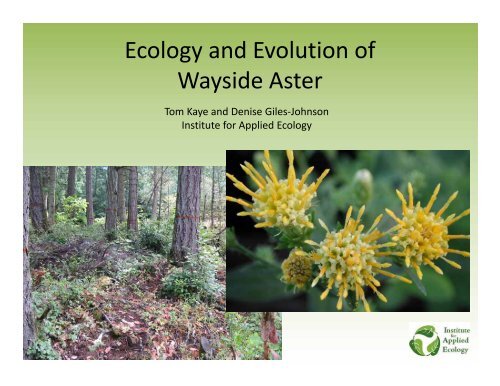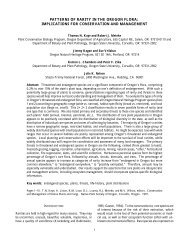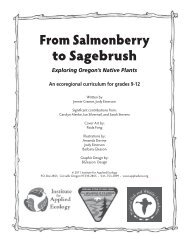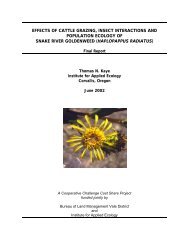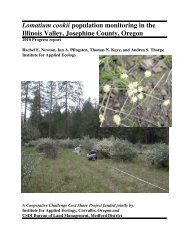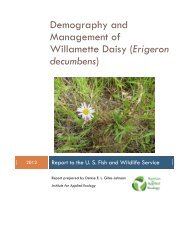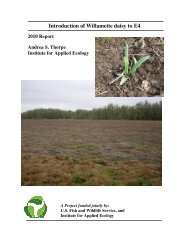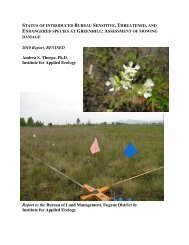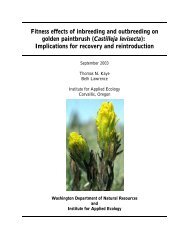Wayside aster research summary PowerPoint BLM 2012
Wayside aster research summary PowerPoint BLM 2012
Wayside aster research summary PowerPoint BLM 2012
You also want an ePaper? Increase the reach of your titles
YUMPU automatically turns print PDFs into web optimized ePapers that Google loves.
Ecology and Evolution of<br />
<strong>Wayside</strong> Aster<br />
Tom Kaye and Denise Giles‐Johnson<br />
Institute for Applied Ecology
Ecology and Evolution of<br />
<strong>Wayside</strong> Aster<br />
2002‐<strong>2012</strong>…<br />
• Canopy thinning<br />
• Fire (prescribed)<br />
• Population augmentation or introduction<br />
– Effects of simulated herbivory<br />
– Factors affecting seedling establishment<br />
• Evolutionary relationships
<strong>Wayside</strong> <strong>aster</strong> ‐ distribution
Typical flowering plant Forest habitat
Effects of forest thinning<br />
• Aster growth, reproduction, survival<br />
• Associated habitat changes<br />
• Invasive weed risks
Closed canopy forest habitat (average = 96% canopy closure)
Suppressed plant
Clearcut, Gowdyville Rd
•17 sites in Linn and Lane<br />
County<br />
•6 sites received thinning<br />
treatment (red)
Data:<br />
• Aster plant size and<br />
reproduction<br />
• Associated plant<br />
abundance<br />
• Light availability<br />
(canopy)<br />
• Herbivory
Tagged plant
Data collection, Weiss Road
Data collection: measuring plant height
Average solar radiation<br />
increased from 4% to 15%<br />
after treatment<br />
Effects of thinning
Number of plants remained stable<br />
Plants became larger after thinning<br />
Plants flowered more after thinning<br />
Number of Plants<br />
15 20 25 30 35<br />
30 35 40 45 50 55<br />
Plant Height (cm)<br />
0 2 4 6 8 10 12 14<br />
Number of Capitula<br />
2001 2002 2003 2004 2005 2006 2007 2008 2009 2010<br />
Thinned<br />
Control<br />
2001 2002 2003 2004 2005 2006 2007 2008 2009 2010<br />
2001 2002 2003 2004 2005 2006 2007 2008 2009 2010
Proportion dead<br />
0.00 0.10 0.20<br />
Mortality<br />
Before<br />
After<br />
Control Thinned<br />
Plant mortality was higher in control than thinned plots<br />
after treatment.
Community responses<br />
• Thinning resulted in an<br />
increase in native forbs<br />
(15% to 25%) and some<br />
shrubs.<br />
• Native grasses<br />
increased (1% to 5%)<br />
• Small increases in<br />
weeds:<br />
– St John’s wort<br />
– Blackberry spp.<br />
– Tansy ragwort<br />
– False‐brome (hand<br />
pulled)<br />
NMDS2<br />
-0.6 -0.4 -0.2 0.0 0.2 0.4 0.6<br />
3<br />
2<br />
1<br />
Community Composition<br />
13<br />
12<br />
6<br />
8<br />
19<br />
11<br />
7<br />
5<br />
10<br />
16<br />
-0.5 0.0 0.5<br />
NMDS1<br />
9<br />
4<br />
14<br />
15<br />
18<br />
Control<br />
Thinned
Summary‐ Effects of Canopy Thinning<br />
• Plants were larger and had more flowers in<br />
thinned plots<br />
• Mortality was lower in thinned plots<br />
• Cover of native forbs and native grasses<br />
increased in thinned plots<br />
• (Invasive species increased slightly)
Effects of fire
Four years after burning (2002‐2006)<br />
Control (thinned, not burned) Burned (thinned and burned)
Burning at Weiss Road<br />
• Plants recovered in both burn types<br />
• Invasive grasses increased in swamper burns
Propagation and introduction<br />
• Propagation techniques<br />
• Transplanting<br />
• Seeding<br />
– Factors that affect seedling establishment<br />
– Light availability, litter/moss vs. bare soil
Greenhouse propagation
• Seeds germinate<br />
after 3 months of<br />
cold.<br />
• Or, if seed coat<br />
removed, 2 weeks
Simulated herbivory<br />
• Clipping reduced<br />
flower production<br />
• Fertilizer increased<br />
plant size<br />
• Deer lower<br />
population viability
Observation: Seedlings occur on exposed soil
Seeded –bare soil<br />
Transplants<br />
Seeded
First year seedling Second year seedling<br />
Long Hill site
Number of transplants/plot<br />
0 1 2 3 4<br />
Transplanting and seeding<br />
2002 2004 2006 2008 2010<br />
Year<br />
Number of transplants<br />
per plot 2002‐2010.<br />
Number of Plants<br />
0 1 2 3 4<br />
2002 2004 2006 2008 2010<br />
Year<br />
no scrape<br />
scrape<br />
Seedling establishment<br />
2002‐2010.
Conclusions<br />
• Seeds can be germinated and grown<br />
• Transplants and seeds can establish new<br />
plants<br />
– Both work, transplanting may be more efficient<br />
• Deer browse is a threat to population growth.
Evolution ‐ Taxonomy<br />
• Aster Eucephalus<br />
– Rayless <strong>aster</strong>s<br />
– Aster vialis Eucephalus vialis<br />
• Related species:<br />
– E. vialis<br />
– E. tomentellus (=A. brickellioides)<br />
– E. glabratus (=A. siskiyouensis)<br />
– E. breweri (intergrades with tomentellus and<br />
glabratus)
Rayless Eucephalus
• Objective:<br />
Evolution ‐ Taxonomy<br />
– Resolve taxonomic boundaries to determine<br />
conservation status
Variation in DNA<br />
sequences (based on<br />
1198 base pairs of<br />
combined ITS and ETS<br />
regions) obtained from<br />
Eucephalus vialis and<br />
related species. The<br />
network connects<br />
sequences of greatest<br />
similarity; each<br />
connecting line<br />
represents a single base<br />
substitution.<br />
Genetic results<br />
Group 1<br />
sequences<br />
Group 2<br />
sequences<br />
Josephine Co.<br />
I<br />
H<br />
J<br />
F E G<br />
C B<br />
A D<br />
L<br />
P<br />
N<br />
K<br />
O<br />
Q<br />
M<br />
R<br />
Lane Co.,<br />
Douglas Co.,<br />
Josephine Co. (N)<br />
Jackson Co.,<br />
Josephine Co.<br />
Jackson Co.
vialis<br />
tomentellus<br />
glabratus<br />
breweri
Lane<br />
Douglas<br />
Jackson<br />
Josephine<br />
Curry<br />
California
Rayless Eucephalus
But wait, there’s more
Conclusions<br />
• Plants identified as Eucephalus vialis are genetically differentiated in<br />
the northern and southern parts of their range.<br />
• All E. vialis populations in Lane and Douglas Counties appear to be<br />
genetically very uniform, with a small number of closely related<br />
genetic variants.<br />
• Group 1 sequences are allied to ITS and ETS sequences from E.<br />
ledophyllus.<br />
• Group 2 sequences reported here are similar to ITS and ETS<br />
sequences from E. breweri and E. engelmannii.<br />
• mixtures of Group 1 and Group 2 sequences in the Josephine and<br />
Jackson Co. populations sampled for this study suggests that these<br />
southern populations have been strongly influenced by<br />
hybridization, most likely with E. breweri. This is probably true of E.<br />
tomentellus as well.
Overall conclusions<br />
• Thinning can promote growth and flowering in<br />
wayside <strong>aster</strong>.<br />
– Need to revisit sites to search for young plants.<br />
• The species tolerates fire.<br />
• Small populations can be augmented, and new<br />
populations can improve connectivity.<br />
• E. vialis occurs in Lane and Douglas Counties only.<br />
Southern populations are hybrids or other taxa.<br />
– Need to understand relationship to rayed Eucephalus.
Acknowledgments<br />
• IAE: Jen Cramer, Carolyn Menke, Burl Martin,<br />
Rob Massatti, Ian Pfingsten, Rachel Newton,<br />
Amy Young, Amanda Stanley, Andrea Thorpe,<br />
many interns!<br />
• <strong>BLM</strong>: Nancy Sawtelle, Cheshire Mayrsohn,<br />
Molly Widmer<br />
• USFS: Wayne Rolle, Maureen Jules


